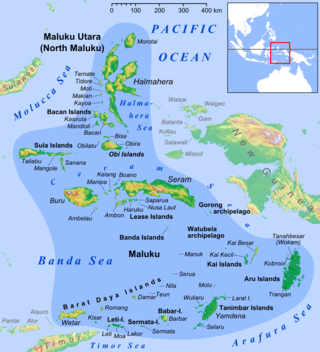
The Maluku Islands or the Moluccas are an archipelago in the eastern part of Indonesia. Tectonically they are located on the Halmahera Plate within the Molucca Sea Collision Zone. Geographically they are located east of Sulawesi, west of New Guinea, and north and east of Timor. Lying within Wallacea, the Moluccas have been considered a geographical and cultural intersection of Asia and Oceania.
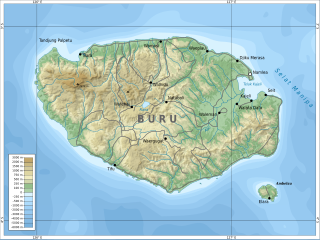
Buru is the third largest island within the Maluku Islands of Indonesia. It lies between the Banda Sea to the south and Seram Sea to the north, west of Ambon and Seram islands. The island belongs to Maluku province and includes the Buru and South Buru regencies. Their administrative centers, Namlea and Namrole, respectively, have ports and are the largest towns of the island, served by Namlea Airport and Namrole Airport respectively.
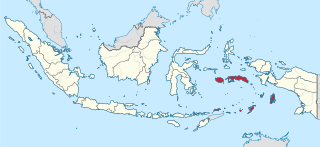
Maluku is a province of Indonesia. It comprises the central and southern regions of the Maluku Islands. The largest city and capital of Maluku province is Ambon on the small Ambon Island. It is directly adjacent to North Maluku, Southwest Papua, and West Papua in the north, Central Sulawesi, and Southeast Sulawesi in the west, Banda Sea, Australia, East Timor and East Nusa Tenggara in the south and Arafura Sea, Central Papua and South Papua in the east. The land area is 57803.81 km2, and the total population of this province at the 2010 census was 1,533,506 people, rising to 1,848,923 at the 2020 census, the official estimate as at mid 2023 was 1,908,753. Maluku is located in Eastern Indonesia.
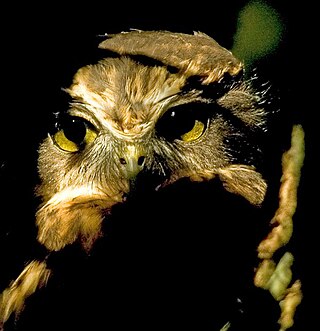
Ninox is a genus of true owls comprising 36 species found in Asia and Australasia. Many species are known as hawk-owls or boobooks, but the northern hawk-owl is not a member of this genus.
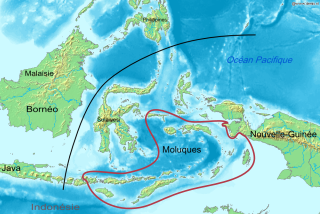
The Central Malayo-Polynesian languages (CMP) are a proposed branch in the Malayo-Polynesian subgroup of the Austronesian language family. The languages are spoken in the Lesser Sunda and Maluku Islands of the Banda Sea, in an area corresponding closely to the Indonesian provinces of East Nusa Tenggara and Maluku and the nation of East Timor, but with the Bima language extending to the eastern half of Sumbawa Island in the province of West Nusa Tenggara and the Sula languages of the Sula archipelago in the southwest corner of the province of North Maluku. The principal islands in this region are Sumbawa, Sumba, Flores, Timor, Buru, and Seram. The numerically most important languages are Bima, Manggarai of western Flores, Uab Meto of West Timor, and Tetum, the national language of East Timor.

The Moluccan megapode, also known as Wallace's scrubfowl, Moluccan scrubfowl or painted megapode, is a small, approximately 31 cm long, olive-brown megapode. The genus Eulipoa is monotypic, but the Moluccan megapode is sometimes placed in Megapodius instead. Both sexes are similar with an olive-brown plumage, bluish-grey below, white undertail coverts, brown iris, bare pink facial skin, bluish-yellow bill and dark olive legs. There are light grey stripes on reddish-maroon feathers on its back. The young has brownish plumage, a black bill, legs and hazel iris.

The Moluccan scops owl is an owl found in the Maluku and Lesser Sunda Islands of Indonesia. It closely resembles the Rinjani scops owl.
The least boobook, also known as the little Sumba hawk-owl or little Sumba boobook, is a species of owl in the family Strigidae. It is endemic to the Indonesian island of Sumba. Its natural habitat is subtropical or tropical moist lowland forests. It is threatened by habitat loss.

The Buru friarbird or black-faced friarbird is a species of bird in the family Meliphagidae. It is endemic to the island of Buru in the Maluku Islands, Indonesia.

The Halmahera boobook is a species of owl in the family Strigidae. It inhabits the Indonesian islands of Halmahera, Ternate and Bacan. Its natural habitat is subtropical or tropical moist lowland forests. It is threatened by habitat loss. It was previously considered to be a subspecies of the Moluccan boobook.
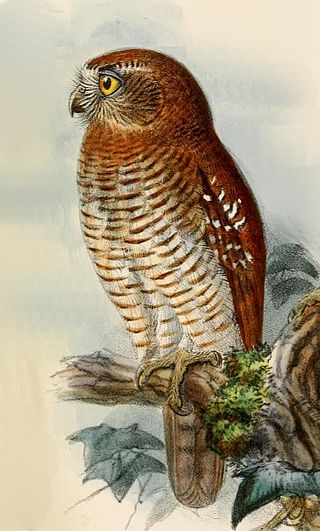
The Seram boobook, also Hantu boobook, Moluccan boobook or Moluccan hawk owl, is a species of owl in the family Strigidae. It is found on the Indonesian islands of Seram, Kelang and Ambon. Its natural habitat is subtropical or tropical moist lowland forests. It is threatened by habitat loss. It used to be considered a subspecies of the Moluccan boobook.
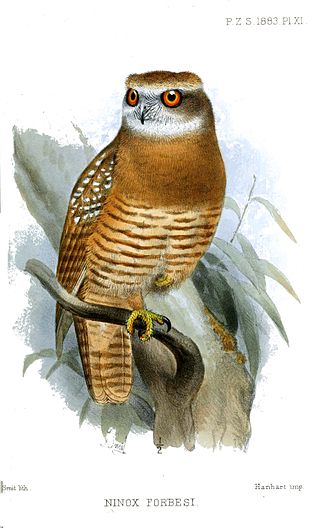
The Tanimbar boobook, or Tanimbar hawk-owl, is a species of owl in the family Strigidae. It is found in the Tanimbar Islands of Indonesia. Its natural habitat is subtropical or tropical moist lowland forests. It is threatened by habitat loss. It used to be considered a subspecies of the Moluccan boobook.
The Halmahera swiftlet or Moluccan swiftlet is a species in the family Apodidae. It is endemic to North Maluku, Indonesia.
The Rote boobook is a species of owl in the family Strigidae. It is endemic to Rote Island in the Lesser Sunda Islands of Indonesia.
The Timor boobook is a species of owl in the family Strigidae. It is found on Timor, Roma, Leti and Semau Islands in the eastern Lesser Sunda Islands of Indonesia.
The Buru boobook, is a species of owl in the family Strigidae. It is found in Indonesia. Its natural habitat is subtropical or tropical moist lowland forests. It is threatened by habitat loss. It used to be considered a subspecies of the Moluccan boobook.
The Tasmanian boobook, also known as the Tasmanian spotted owl, is a species of owl in the family Strigidae. It is native to Tasmania.











